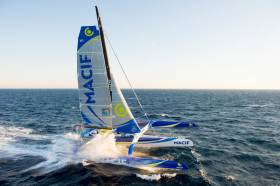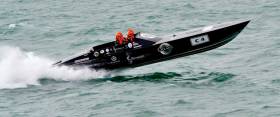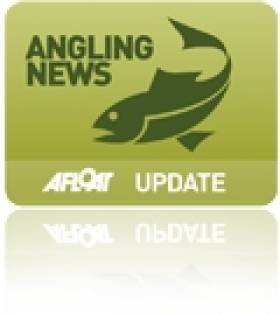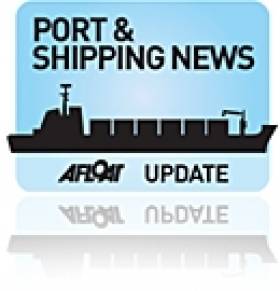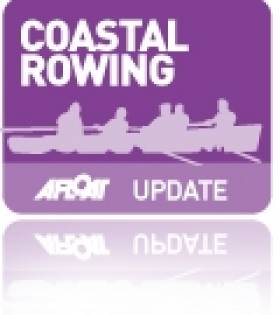Displaying items by tag: records
British Duo Set New Round Ireland RIB Speed Record
#Record - Marc Lyne and Dean Watson have smashed the longstanding under-30ft Round Ireland powerboat record by almost half an hour, pending UIM ratification.
On Friday 13 July last the duo set a provisional time of 18 hours and 12 minutes — some 25 minutes faster than Philip Fitzgibbon and Mike Shanahan’s RIB record of 18:38:50 set in 2009.
And Lyne claims the time could have been more than two hours’ better “if we had not been beaten up for the last 40 miles from Cork to Crookhaven”.
While Team Hibernia set a sub-13-hour time with their wave-piercing powerboat in 2016, the record for under-30ft boats was still standing. And that’s the time on which Lyne and Watson put their sights after breaking the Round Anglesey time, in Watson’s home waters, back in 2015.
Over the next three years, the pair set about preparing their boat, a Scorpion 8.5m RIB dubbed Ocean Devil, to make the most of its Yanmar 315HP inboard engine.
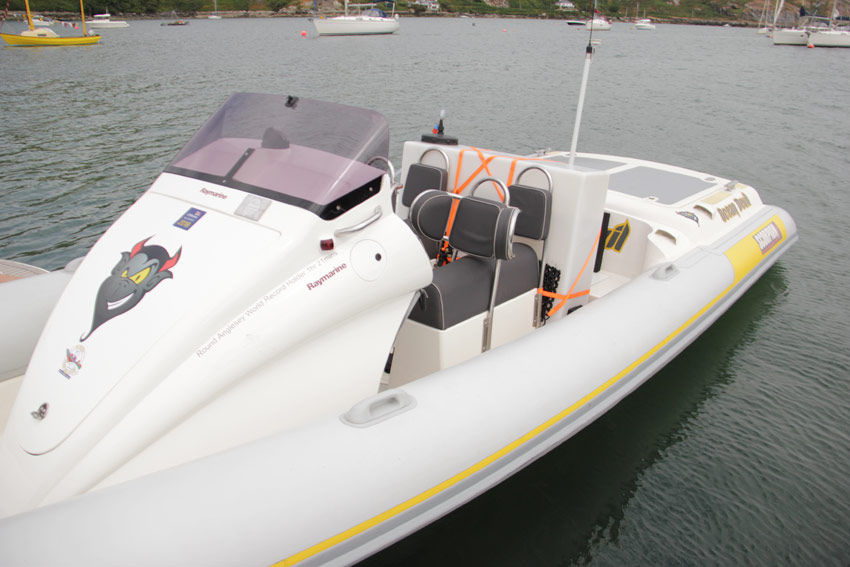 The Scorpion 8.5m RIB Ocean Devil prepped and ready to go
The Scorpion 8.5m RIB Ocean Devil prepped and ready to go
That involved a series of main prop modifications, as well as the installation of new fuel tanks with 400 litres’ capacity in addition to the 363l main tank, all while still getting as close as possible to the RIB’s top speed of 51 knots without revving over 3,750 rpm.
A key element of their set-up was using gravity to tap into the main tank through the service hatch by the helm, to avoid the use of battery-sapping pumps adding unnecessary weight.
With 45 knots achievable when fully loaded, and the engine mount put through rigorous sea and wake trials in the Solent, the next step was to reduce the overall weight. That meant new batteries, courtesy of DMS Technologies, and replacing the heavy A-frame with a removable radar post and a carbon post for the VHF antenna.
Safety remained paramount in their modifications, with all navigation lights replaced by LEDs, a new radio with built-in AIS from Raymarine, and a full set of offshore flares.
With the new and improved Ocean Devil ready for action, what Lyne and Watson needed next was a winning strategy. Cue a consolation with Mike Deacon, a RIB speed record breaker in his own right, who offered a list of suggestions — the most important of which was to wait till the weather was just so.
“The reason he and David his son had never attempted the Ireland world record was that you had to get the weather exactly right, and that would mean having the boat in Ireland and ready to go at 24 hours’ notice,” Lyne says. “So really, the people best placed to attempt the record were already in Ireland.”
Fast forward to summer 2018 — the best experienced in Ireland for years — and all the pieces were in place for a record run.
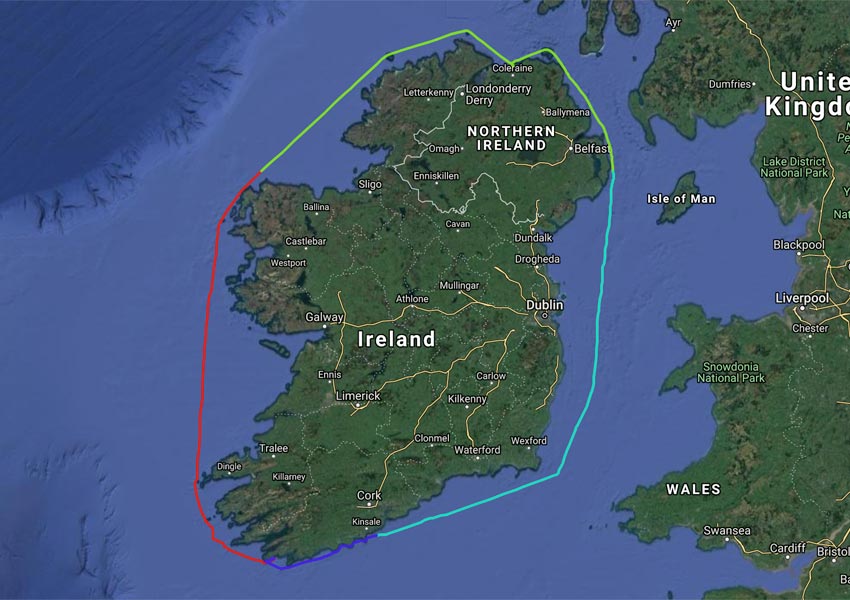 Course plotted: Lyne and Watson’s planned stages around the Irish coast
Course plotted: Lyne and Watson’s planned stages around the Irish coast
With the support of Denis Dillon at Irish Sailing, and Stena Line’s Fishguard-Rosslare ferry route, Lyne and Watson were soon in Skibbereen fuelling up ahead of their planned start in Crookhaven.
Dillon put the duo in touch with Justin McInerney, a previous Round Ireland record holder with Team Pulsar Racing, who would be their official timer on the day. His advice on the best stops to avoid busy slipways would prove crucial to their success.
With their boat and safety equipment checked over, and the passage plan forward to Ireland’s four main coastguard stations, Lyne and Watson made an early start at 4am on Friday 13 July.
That date would be true to its reputation as the duo rounded their first headland and ploughed headlong into a confused three-metre sea, halving their speed to 25 knots.
Thankfully that struggle was only for the first hour, and the rest of the day would prove to be an exceedingly lucky one, with flat seas and quick refuelling stops most of the way from Kerry to Portrush to Rosslare.
Spirits were high as the duo neared Cork late on Friday afternoon to complete their loop, only to run into that confused sea state once more — and a mishap on leaking hydraulic fluid that saw Watson bash his knee on top of a strained hip.
Lyne recalls of those dreaded final hours: “We can’t get any speed without getting hit hard occasionally which is taking its toll on both of us as we have been going for 16 hours. We duck behind the headlands, get some speed, then get beaten up as soon as we have to round the next headland.
“We remember to cut outside of all charted land as there are a few very small islands marked in some of the bays. We are losing a lot of time; rough calculations show us matching the current record – no!”
A little further on, and their situation improves: “I have the heading line on the plotter set to 12 miles, and can see the length of the line versus Fastnet Rock, which we are to round and then head towards Mizen Head,” Lyne remembers. “It’s three line lengths and we are down to 25 knots … that’s an hour and a half, that means we will equal the record.
“Dean moves to sit behind me so he can use his legs efficiently to cushion any impact without slipping.
“All good, we are on top of it now, back up to 35kt, then 40kt. The waves are getting smaller and more regular as we get to Fastnet Rock, round Fastnet, to finish at Mizen Head, torch in hand.
“Justin is on the radio: ‘Congratulations lads, you have done it.’”
Attempting and breaking this record “has taught me a few other things about life, boating and Ireland,” Lyne says, singling out Justin McInerney and “superstar” Denis Dillon for their assistance.
“I started a conversation with Denis over a year ago, and once he knew we were serious for July 13th, he did everything in his power to make it happen.”
McInerney, meanwhile, put in a call to Philip Fitzgibbon, one of the record holders Lyne and Watson have tentatively dethroned, to tempt a comeback challenge somewhere along the line.
As for Lyne and Watson’s trusty Ocean Devil, and how it fared from those 18 hours at sea? Nothing broken, though a handful seals need replacing — surprising little needed after so long flat out around the island of Ireland.
Besides Denis Dillon at Irish Sailing, and Justin and Antoinette McInerney, Lyne and Watson also expressed their tanks to Raymarine, DMS Technologies, Stena Line, BIBOA (Mike Deacon, Chris Strickland, Neil McGrigor), Claire at Marconi House in Crookhaven, and Mark at the Barleycove Beach Hotel near Mizen Head.
Record-Smashing 2017 Offshore For North Sails
#NorthSails - North Sails Ireland is looking back on a record-breaking year in 2017 for the global sailmaker's offshore clients, all of whom were using its 3Di performance sails.
Last January, Armel Le Cleác’h sailed Banque Populaire VIII around the world solo in the Vendée Globe in 74 days, 3 hours, 35 minutes and 46 seconds, breaking the solo (monohull) round-the-world record.
That same month, Francis Joyon with his IDEC Sport crew took the Jules Verne Trophy for the fastest global circumnavigation ever: an incredible 40 days, 23 hours and 30 seconds.
During the summer, records were falling so fast that North Sails had a hard time keeping up: Team Concise in the Round the Island; Mighty Merloe and Comanche in the Transpac; Joyon’s IDEC and Thomas Coville’s Sobeto Ultim in the Transatlantic Outright; Prospector in the Marblehead to Halifax.
Come November, Coville did it again, in tandem with Jean-luc Nelias on Sodebo in the Transat Jacques Vabre. Indeed, taking in his solo circumnavigation record in December 2016, he must hold a personal record for the most sailing records broken in a single 12-month period.
What’s more, North Sails estimates that Coville’s 3Di Endurance mainsail had 75,000 miles (the equivalent of three times around the world) logged when he broke that singlehanded east-about circumnavigation time.
More recently, in December, Christmas came early for Francois Gabart when he and his MACIF took the outright solo around-the-world record by lapping the planet in 42 days, 16 hours, 40 minutes and 35 seconds. (The team also set a new 24-hour distance mark to beat in November.)
The final record of 2017 went to LDV Comanche, who set the pace for future Rolex Sydney Hobart Races with a time of 1 day, 9 hours, 15 minutes and 24 seconds.
With that results in the books, North Sails Ireland in Myrtleville raises a toast to its offshore clients who continue to push its products to the limit.
#Powerboats - An Irish-based powerboat racing team is aiming for a full 11 offshore endurance and speed records over the next three years.
“It’s ambitious, but it’s do-able,” as Red Bull hears from John Ryan, team driver and throttle man with Allblack Racing and an Afloat.ie Sailor of the Month in his own right for Team Hibernia’s record-smashing Round Ireland powerboat run.
The 11 challenges of the Union International Motonautique (UIM) offshore ocean endurance long distance and speed records represent a step beyond for Ryan and his team mates.
Allblack Racing will take to Irish waters again for the Cork-Fastnet loop and the Round Britain and Ireland challenge, as well as the Round Anglesey run in the Irish Sea and Menai Strait.
The team will also tackle various taxing European routes such as an Italian speed trial from Naples to Capri, a blast between the Channel Islands and the Isle of Wight, and a straight 60-hour run from London to Monte Carlo.
That’s not to mention the epic routes from London to St Petersburg and Miami to New York that will complete the list — all raced on the team’s Swedish-designed Allblack SL44 that's been specially adapted for extreme racing.
Allblack from Konjow Films on Vimeo.
What’s more, there’s an opportunity for additional passengers to join Ryan and his team mates Philip Fitzgibbon and Ant Middleton — if you can bring funding for the demands of each record, you could get trained up and listed as co-driver for the fourth seat on the boat.
Red Bull has much more on the story HERE.
Two New Specimen Fish Records In 2015
#Angling - The Irish Specimen Fish Committee has just ratified two new Irish record fish.
Dublin angler Tom Lynch has broken the Irish twaite shad record with a 1.64kg specimen from the River Barrow at St Mullins, caught on 15 May last, while the new smooth hound record was broken by Gareth Murphy with an 8.62kg whopper from Wicklow Bay on 24 May.
Full details are in the Irish Specimen Fish Committee report for 2015 which just been released and is available on the ISFC website or from the Inland Fisheries Ireland website.
As well as the new record fish, detailed information on almost 450 specimen fish (ie large fish) taken by anglers from venues throughout Ireland in 2015 are presented.
Hard copies of the report will be available from 18 January from Inland Fisheries Ireland offices nationally.
The new report has details of 45 different species of specimen fish taken by anglers in 2015.
Thirty-two different species (including blue shark, pollock, several species of ray, gilthead bream, etc) were taken by sea anglers while freshwater anglers accounted for the remaining species.
Particularly large numbers of specimen thick lipped mullet (16% of total ratified) and smooth hound (14%) were caught, weighed and released, and in freshwater, carp (10%) dominated specimen returns. Large numbers of the exotic mullet species, golden greys and thin-lipped, were also ratified.
The ISFC Awards Day, when anglers will be presented with their awards and certificates, will be held on Saturday 20 February in Dublin in conjunction with the Irish Angling Show weekend.
Meanwhile, anglers both at home and abroad will be reading the report carefully to plan their angling trips to catch the big fish in Ireland in 2016.
Download a PDF copy of the Irish Specimen Fish 2015 report HERE.
Specimen Awards Recognised 2014 Angling Records
#Angling - Four Irish angling records set in 2014 were recognised at the recent Irish Specimen Fish Awards, as Derek Evans writes in The Irish Times.
Aaron Cummins, Ian Mulligan, Stephen O'Neill and Tom Walsh were all noted for their respective record landings of carp, thin-lipped mullet, golden grey mullet and spur dogfish between June and October last year, as previously reported on Afloat.ie.
And the ceremony at Bewley's Hotel in North Dublin, with a keynote address by broadcaster and angler Derek Davis, also saw Conor Ward of Balintglass, Co Wicklow receive the Dr Arthur Went Award for young specimen angler of the year for his 5.75lb roach/bream caught at Lough Nablahy in Roscommon.
The Irish Times has more on the story and other angling news HERE.
Four Irish Angling Records Smashed In 2014
#Angling - Four new records dominate the record fish list for 2014 which has just been published by the Irish Specimen Fish Committee (ISFC).
The most recent is a new record carp of 14.24kg caught by Aaron Cummins at Loughgall in Co Antrim on 26 October.
In August a new thin-lipped mullet record was set by Ian Mulligan, who reeled in a 2.86kg specimen at Clonakilty, Co Cork on the 23rd of the month.
Also in Cork, Stephen O'Neill set the new golden grey mullet record with his 1.2kg catch in Cork Harbour on 16 July.
And Tom Walsh is in the books for his 11.06kg spur dogfish landed at Red Bay, Co Antrim on 3 June.
The ISFC says 2014 was a very good year for anglers, with large numbers of specimen-sized fish caught besides the four new records established.
High water temperatures during the summer meant very good news for many sea anglers, with some of Ireland’s more exotic species like thin lipped mullet, golden grey mullet and gilthead quite prominent in the overall specimen fish listings. Specimen painted ray and thick-lipped mullet were also plentiful.
A total of 526 specimens were ratified in 2014, and the ISFC expects anglers both at home and abroad will be reading the report carefully to plan their angling trips in 2015, with the new year seeing tope, spurdog, smooth-hound and blue shark allowable as length-based specimens.
In other specimen fish news, the ISFC Awards Day will be held on Saturday 21 February to coincide with the Irish Angling Show weekend.
Invitations will be issued to anglers from Ireland next week. If any angler plans to attend, contact [email protected] as soon as possible.
Overseas anglers are also very welcome to attend. Certificates, etc will be posted to anglers who cannot attend, and it is intended to present anglers in the Netherlands with their awards at the VISMA 2015 angling show in Rotterdam.
The 2014 Irish Specimen Fish report is available as a PDF to read or download HERE.
Hard copies of the report will be available free of charge from the Inland Fisheries Ireland offices in Citywest Business Campus, Dublin 24 in early January. For further information contact ISFC secretary William Roche at 01 884 2600.
Galway Windsurfers Set Paddle Board Record
#Surfing - A trio of Galway windsurfers completed the 95km round trip to and from the Aran Islands last weekend - setting a new Irish record for stand-up paddle boarding in the process.
The Irish Times reports on the successful adventure by Dan Gardner, Daniel King and Joe Gallagher, who embarked on the challenge to raise funds for the Galway RNLI lifeboat service.
Setting out before 5.30am on the morning of Saturday 8 June, they returned to the Galway Docks before 11pm that night - stopping at the halfway mark for lunch on Inis Mór.
The trio are each believed to have covered some 4,000 strokes an hour to make their record time of 17 hours 33 minutes. The Irish Times has more on the story HERE.
In other surfing news, the Sunday Independent reports on a website that's seeking to connect surfers of all levels with the right waves for them.
Waterford-based Liam Sinnott set up Swellseekers.ie with business partner James Hassey two years ago, filling a gap in the market for booking surfing trips online at a time when Ireland was only just emerging as a world-class surfing destination.
Though the site currently only takes bookings for surfing and other watersports in the Waterford area, Sinnott says he hopes to expand his site's scope nationwide by next year to serve a growing wave-riding community of "50,000 surfing all year round".
#MarineNotice - Marine Notice No 17 of 2013 from the Department of Transport, Tourism and Sport (DTTAS) advises on two minor amendments to ship security plans and on-board retention of security records, in accordance with Regulation (EC) No 725/2004 and the International Ship and Port Facility Security Code (ISPS Code).
Firstly, and with immediate effect, there is no requirement to inform the Marine Survey Office of minor amendments to ship security plans.
Such minor amendments include amendments to contact details of shipping company personnel, and may also include other minor adjustments to the text. Minor amendments are such that the structure, scope and implementing measures contained in the plan are not amended.
If in any doubt the company security officer should contact the Marine Survey Office for further guidance. All amendments should be recorded appropriately.
Secondly, the DTTAS advises that, with immediate effect, the minimum period for the retention of security records on board (relating to drills, exercises, declarations of security, etc) is reduced to three years.
Humpback Whale Spotted Off Achill
#MARINE WILDLIFE - The Irish Whale and Dolphin Group has confirmed the sighting of a humpback whale off Achill Island in Co Mayo last weekend.
Surfers off Keel Beach were credited with the discovery, after spotting a large whale of 30-60ft breaking the surface multiple times, lifting its tail fluke vertically.
The sighting is only the fifth validated record of a humpback whale off the coastal area from Galway to Donegal.
"It remains something of a mystery as to why sightings of this species remain such relatively rare events along our west and northwest compared to our south and southwest coasts," says IWDG sightings co-ordinator Pádraig Whooley.
"This latest sighting is a timely reminder that species such as humpbacks can and do turn up in places that are well outside what we perceive to be the known 'hotspots'."
Humpback whales tend to feed in inshore waters, which should make them increasingly easier for the public to spot from the shore, he added.
The IWDG has more on the story HERE.
Ocean Rowers Begin Atlantic Record Attempt
The crew of the Sara G have begun their latest attempt on the world record for the fastest crossing of the Atlantic by an ocean rowing boat.
The six-man crew - skippered by Sara G owner Matt Craughwell and featuring Irishmen Adam Langton Burke from Skerries and Bray native Rob Byrne - set off from Tarfaya in Morocco on Wednesday afternoon, headed for Barbados.
The 11.1m boat has a storied history, smashing the record for the fastest row across the Tasman Sea from New Zealand to Australia with its previous owner Steven Gates.
Last year the Sara G crossed the Atlantic for the first time from Agadir to Barbados in 57 days, 20 hours. This year's crew must beat a time of 38 days, 1 hour and 22 minutes to take the record held by Team La Mondiale since 2008.
Rowing southwest to take advantage of the trade winds, the Sara G is presently off the coast of north-west Africa near the Canary Islands.
Click HERE to track the crew's live progress across the Atlantic.





























